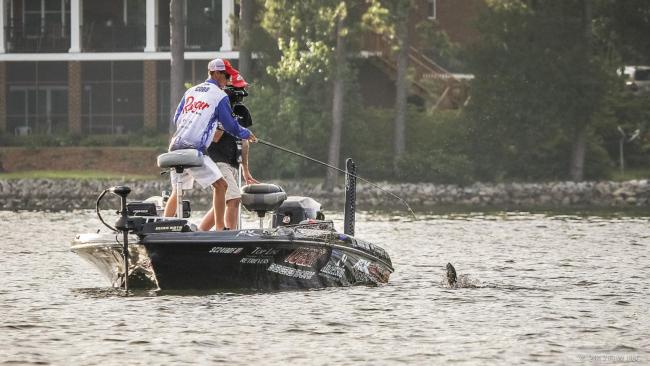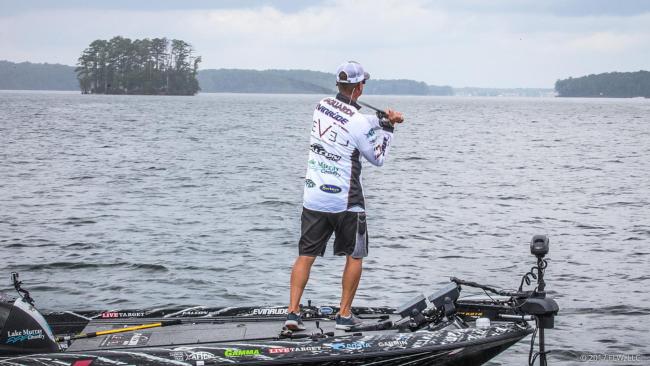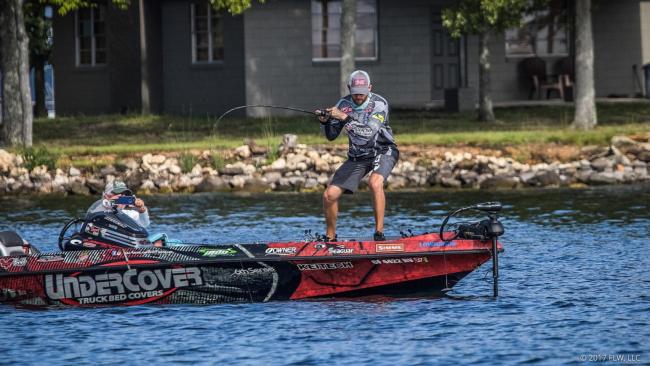Lake Murray Top 10 Patterns
Shallow was decidedly not the way to go

The idea that the offshore patterns available on the lower end of Lake Murray would play in the Forrest Wood Cup was never far from anglers’ minds. After all, Brent Ehrler nearly won the 2014 Forrest Wood Cup on Murray by fishing brush almost exclusively in the lower end, and a heavy dose of schooling fish propelled Anthony Gagliardi to the win. Of course, that same year, many of the top 10 pros fished the bank, and Scott Canterbury was literally a fish away from nailing down a win with a bank-running pattern.
This time around, the offshore stuff in the lower end set up better than ever, and unheard-of weights hit the scale. According to Gagliardi, the excellent offshore bite was available mostly because of the conditions. With slightly cooler weather and water (the water temperatures hovered in the mid- to upper 80s during the event), the oxygen content stayed good farther down into the water column than it sometimes does in mid-August, prompting the bass to remain offshore instead of forcing them to the bank. A month of steadily dropping water likely helped the offshore bite as well, at least by comparison to the shallow bite. In 2014 the water level was higher and largely stable. This year, it steadily dropped out of some of the best shallow cover.
Champion Justin Atkins put together three excellent days targeting cane piles with a topwater, but that wasn’t the only way to have a good week on Murray. All in all, each of the top 10 pros put together an impressive tournament, and all were on pace to blow the doors off the winning weights from each of the prior Cups held on Murray.
2. Fox targets schoolers
Fishing the Cup for the first time, Travis Fox didn’t run and gun like Atkins and Brandon Cobb. Rather, the Arkansas angler who qualified out of the Costa FLW Series elected to sit on a few points, including one special point for most of the final day. He caught no more than six or seven fish on most days but was around the right size and totaled up 56 pounds, 11 ounces on the tournament, including a 21-11 bag on the final day, which only Atkins eclipsed.
Fox says he found the first cane pile of his life on the final day of the tournament and promptly tossed a marker buoy out on it. Suffice to say, he wasn’t dialed in to that particular pattern. His main program was to fish and wait on a handful of points in the lower end of Murray. What set him apart a bit was the depth he was targeting. Instead of fishing way off the point, he kept his boat in about 20 feet or less and targeted the first sharp break. Fox did plenty of casting, but he also simply waited, rod at the ready, for fish to bust.
Fox mostly threw an ima Little Stick 135 but swapped it up for a Storm Arashi Top Walker and a Strike King Sexy Spoon on the final day. He cast the topwaters to breaking fish, but caught a kicker on the last day just stroking the spoon through the general area. One unique equipment choice Fox made was to throw his topwaters on 14-pound-test Sufix Elite mono.
3. Cobb struggles on the final day
Making his third Forrest Wood Cup top 10 in a row, Brandon Cobb only weighed four bass on the final day to fall off the lead and finish with a 54-10 total.
Like Atkins, Cobb was running and gunning, fishing cane piles and other more subtle places on points where he knew fish were suspending.
“I feel like I did what I needed to do,” says Cobb. “I would have caught them today [Sunday] if I’d put them all in the boat. Yeah, it was tough, but I had the bites.
“I think the problem today was the fish got up and wanted to school, so they weren’t sitting where I wanted them to be. I think I would have been better off staying on some places more. Normally, in my experience on herring lakes, when they’re schooling, if they quit, it’s not getting better. They’re easy to catch when you pull up on somewhere, but they get a lot harder the longer you sit there.”
Running and gunning with a ton of spectators also hurt Cobb. While Atkins torched them on Sunday morning with very few spectators, Cobb had a stream of 30 or more boats tagging along through much of days two and three. Though the crowd stayed back for the most part, Cobb wasn’t able to hit multiple places in a small area as effectively, nor did his spots get as much of a chance to rest between visits.
Cobb leaned on topwaters, using a pencil pooper, a Yo-Zuri Hydro Pencil, which is actually an inshore walking plug, and a Yo-Zuri 3DB Pencil in prism ghost shad. He used 15-pound-test Yo-Zuri Hybrid for his line, and cast his baits on Ark Invoker rods, using a 7-6, medium-heavy model for the larger plugs and a 7-foot, medium-power rod for the smaller 3DB Pencil. He also put a Zoom Super Fluke into action, rigging it with a 5/0 hook and a swivel a foot or so ahead of the bait.
4. Thrift falls short again
Bryan Thrift has made a habit of finishing in the top 10 of the Forrest Wood Cup and not having quite enough juice to earn the win. The reigning Angler of the Year has made the top 10 six years running without closing the deal, and it’s only a matter of time before he does. At Murray, the North Carolina pro weighed 51-15 and stayed in the top five the entire tournament.
As he so often does, Thrift mixed things up, catching a few schooling and cane fish in the lower end of the lake on a topwater and the bulk of his fish in brush. He fished brush from the lower end to above Dreher Island, and most of it was in more than 20 feet of water, though he did fish some shallower brush as well. Thrift spent most of his time in creeks, not out on the main lake.
For baits, Thrift used a big pencil popper, a 10-inch worm and a Damiki Finesse Miki rigged on a 1/8-ounce shaky head.
5. The repeat was not to be
The chances that we finally get a two-time champion at the Cup increase every year, and all eyes were on Anthony Gagliardi this time around. Unfortunately for the local favorite, he “got sucked into the schooling bite” and could only muster 15-pound bags the final two days, finishing with a 51-3 total.
Gagliardi roamed the mid-lake region more than the area around the dam, and focused his efforts on schooling fish around cane piles and shoals. Instead of running from pile to pile like Atkins and Cobb, Gagliardi fished more methodically, camping on certain schools and points for a while and waiting for fish to break, or just fishing his way around the area. Sometimes, when he was well off the structure or pile, he fished in more than 30 feet of water.
For baits, the South Carolina pro cast a pencil popper when the fish came up breaking and a Yamamoto D-Shad (mostly single, but on a double rig some) in between.
6. Another strong showing for Neal
Michael Neal hasn’t earned a win above the BFL level yet, but he seems to be constantly in position to do so. Once he does, the rest of the world should probably watch out. At Murray, Neal ran cane piles and totaled up 46-11 over three days.
“I probably had twice as many waypoints on this lake in 2014 than I have now,” says Neal. “There was a lot more cane then, to me, but I went back to the places I had and idled around. If I found more cane that was fresher and newer I marked those, and if they didn’t have anything new there I deleted those waypoints. The ones I re-marked I knew were areas that people had caught fish or there wouldn’t have been new cane there.”
Neal didn’t run spot to spot quite as much as Cobb and Atkins, but he always fished places with cane. So though he targeted a fair amount of fish that were actually schooling, he had a cane pile nearby to cast at if they weren’t showing themselves.
Neal mostly fished in 15 to 22 feet, but he caught the majority of his fish on a weightless (with a swivel) Big Bite Baits Jerk Minnow and a few on the wildly popular ima Little Stick 135.
7. Schoolers keep Suggs in business
Scott Suggs is one of the best when it comes to catching suspended and schooling fish, and he showed off his skills to the tune of 43-3 on Murray. Like other top finishers, he focused on cane piles, but he took a more nuanced approach.
Suggs dialed in to cane piles early, catching an 18-pound bag on his second morning of pre-practice. After confirming his pattern was still alive on the first day of official practice, Suggs spent most of the rest of the time shallow, trying to eliminate options so he could go for broke on the cane with a clear conscience.
“Everything I was doing I was running cane piles, but at certain days and certain times it evolved into sitting and waiting,” says Suggs. “It seemed to me that the boat traffic put so much wash on those cane piles that it pushed them [the fish] out away. They were still feeding on the herring, but they would come up away from the cane piles. It would usually be anywhere from a cast to a really, really long cast away.”
So, after running from pile to pile early, Suggs camped a little in the afternoon, rotating between a few different spots where he knew fish would come up schooling.
Suggs favored the mid-lake section more than the extreme lower end. He primarily cast a chrome Cotton Cordell Pencil Popper and two Zoom Super Flukes, one in crazy chrome and one in albino. He rigged each Fluke on a single-bait rig with a weighted hook.
8. Martin has another good Cup
Over the years, Scott Martin has become a real force fishing for schoolers, and that’s what carried him to the top 10. He didn’t catch a limit on the final day, but still weighed 41-4 over the course of the event.
“When I was trying to figure out if I should go up shallow or go out deep, the smallest fish I caught out deep was like 2 pounds, and there were plenty of decent ones,” says Martin of his practice period. “When I would go up shallow it was random. You’d go and catch one off a grassy point, and then fish grassy points the rest of the day and not get a bite, and then catch one off a log in the back of a creek and never get another bite on a log. It became so random that I don’t know how you could not have a bad day.”
Martin did his work in the lower end of the lake, but didn’t just run cane piles, instead taking the Fox and Gagliardi approach and waiting a bit more for schoolers to show themselves. He never got the pencil popper to work, and instead threw a Yamamoto D-Shad (with a straight-shank hook rigged so it was exposed), an Ever Green Shower Blows 105 and a LIVETARGET Yearling Walking Bait.
9. Strader mixes it up
Wesley Strader is nothing if not versatile, and he showed it on Murray, catching herring fish but also doing some work up shallow. Though he had a rough final day, he did enough both deep and shallow on days one and two to make it into the cut.
Strader started his tournament fishing cane piles on day one and totally flopped. After running way up a creek, he boxed up nearly 14 pounds by throwing a spinnerbait and a crankbait in laydowns. On day two, he worked his way into the cut with fish he plucked from cane piles and schoolers that were breaking over a grassy point in the lake’s lower section.
In the creek, Strader says patience was key, and that it sometimes took 20 or more presentations to one tree before a fish would bite it. There, Strader plied a PH Custom Lures Pooh shallow-running crankbait and a 3/8-ounce chartreuse/white Stan Sloan’s Zorro Bait Co. Wesley Strader Signature Series Bango Blade with a silver No. 4 1/2 Indiana blade and gold No. 3 1/2 Colorado blade.
In the lake, he threw a bone-colored prototype pencil popper from PH Custom Lures that he calls a “Jabberwocky.” On the final day, he had the makings of a good day, both in the cane and on his point, but the fish simply didn’t hook up.
10. Schoolers do the work for Britt
In his first Cup, Aaron Britt totaled up 31-9, largely based on two excellent days chasing schoolers to start the tournament.
Britt caught a couple keepers off docks with a shaky head, but the bulk of his damage was done on two points with a 6th Sense SplashBack 90 popper in the 4K shad pattern and an Ever Green Shower Blows 125 pencil popper in the half mirror wakasagi color.
“The first day I fished in between [schooling activity], which I learned not to do,” says Britt. “It’s almost like the fish are looking at you; as soon as you make a cast one busts about 15 feet from the boat, and by the time you reel back as fast as you can they’re done. You have about a three-second window, and when these fish come up to eat you have to be on top of them.”








